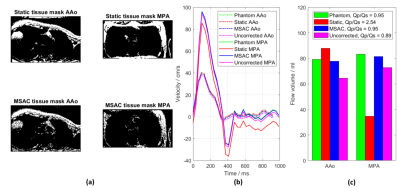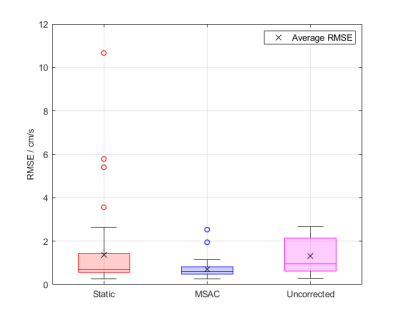Carola Fischer1, Jens Wetzl1, Tobias Schäffter2,3,4, and Daniel Giese1
1Magnetic Resonance, Siemens Healthcare GmbH, Erlangen, Germany, 2Physikalisch-Technische-Bundesanstalt (PTB), Braunschweig and Berlin, Germany, 3Department of Medical Imaging, Technical University of Berlin, Berlin, Germany, 4School of Imaging Sciences and Biomedical Engineering, King's College London, London, United Kingdom
1Magnetic Resonance, Siemens Healthcare GmbH, Erlangen, Germany, 2Physikalisch-Technische-Bundesanstalt (PTB), Braunschweig and Berlin, Germany, 3Department of Medical Imaging, Technical University of Berlin, Berlin, Germany, 4School of Imaging Sciences and Biomedical Engineering, King's College London, London, United Kingdom
MSAC enables robust background phase correction
in presence of wrap-around without extensive parameter tuning. RMSE was reduced
from 1.71±0.34cm/s
(static fit correction) to 0.78±0.07cm/s (MSAC) for wrap-around cases.

Figure 2: A
comparison of masks and flow curves in the AAo and MPA for one volunteer before
and after phantom/second-order correction. MSAC shows superior performance by
avoiding wrap-around regions compared to the static tissue mask (a). This leads
to a correction of the flow curves (b) similar to the phantom correction and
consequently to improved flow volumes and QP/QS-ratio (c).

Figure 5: Boxplot
showing the RMSE performance over all acquisitions. While static fit corrections
are beneficial in most cases compared to no correction, MSAC shows best median
and interquartile performance over all cases. The MSAC outliers correspond to
two images, both with severe wrap-around leading to more wrap-around pixels than
no wrap-around.